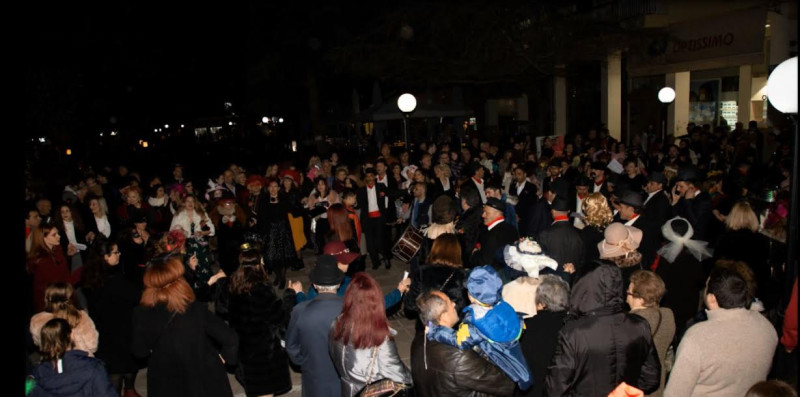The customs of old Arta have been revived since the 1980s
“The Bandidos” will go out into the streets, they will sing and dance while knitting, around the “Carousel”. The people of Artino will have more fun this year at Halloween, because their traditional customs, which have not faded with time, have gained special momentum. Last August, the Ministry of Culture announced that the “Bandidoi and Gaitanaki” Halloween event of Arta was registered in the National Intangible Cultural Heritage Index.
The customs of old Arta have been reviving since the 1980s, the Musico-philological Association of Arta the “Skoufas”, as well as other associations of the city and neighboring villages, bringing out the Gaitanaki and the Bandidos again in the streets of the city, the three days before the Great Halloween .
Nikos Liontos, a member of the Board of Directors at the “Skoufas” club, provides APE-MBE with all the information about the traditional carnival events that have been preserved from generation to generation and give identity to the Carnival of Arta.
The Artino Carnival has its roots in ancient times and continues during the Byzantine period, while during the Turkish rule, under Sultan Murat in Thessaloniki in 1448, the people of Artino obtain the privilege of continuing to have the right to celebrate Halloween and wear masks.
Since the beginning of the 18th century, the Artino Carnival has been enriched with the Bandidos and their satirical couplets, the Carousel, the Panareto, the Janissaries and the Brides, the Bautes, the Gamila, the 7 Powers and the Stickman, the Bear and the Monkey . During the German occupation, the carnival events stopped, then they are kept gradually adapted to the new conditions, they disappear during the Dictatorship and reappear in 1980.
The Bandidos, as mentioned by Mr. Liontos, were groups of young people who went out into the streets of the city in packs, taking advantage of the permission the Sultan had given to the Artins to celebrate Halloween.
They prepared in houses and went out during the last week of Halloween.
All the houses on the days of Halloween were open and welcomed the masquerades (bunches) with traditional pies and wine.
They satirized authority or prominent figures by singing improvised couplets, often with erotic content to externalize their woes. They also went to houses, where the townspeople of Arti were celebrating.
On Clean Monday we meet them under the Turkish guard in the castle. The Turks could not stop them, for they had the permission of the Sultan, and cursed them with couplets, thus bringing out the wrath of the people against the conqueror.
The couplets were invented with the opening of the Trio, while they were preparing their clothes. Almost all neighborhoods of the city participated, Agia Sophia, Parigoritissa, Agios Nikolaos, Agios Georgios, Agia Theodora, Pantokratoras.
In the early years they wore a dress, a headband, a woolen jacket, a red belt and a knife.
Later they wore a jacket only on one arm and a fringed belt to the ground. “You stepped on my belt!” it was the reason for a fight.
The bandits are accompanied by musical groups that entertain the people even more. “The instruments we can’t go to the market, the Turks are afraid of us, they don’t come out.”
This year they will take to the streets, in the last week of Halloween, on Thursday 14 and Friday 15 March. On Friday in Skoufa square they will light a fire and have fun all night.
“Carousel”: The last Saturday of Halloween
“Gaitanaki, one of the favorite Halloween customs in the region of Arta, is still being revived to this day. Perfectly harmonized with the other local customs, since the skill of the dancers and its special character leave no one indifferent”, points out Mr. Liontos.
Along with the Gaitanakia of the city of Arta, the Gaitanakia from the villages of Aneza, Chalkiades, Kostakioi, Grammenitsa, Peta and Komboti were equally famous, which continuously participate in the custom.
The Carousels were woven on the weekend of Tyrini, the last Sunday of Halloween. In Arta, the Carousels started crossing the main street and the neighborhoods, with stops for events, enticing the whole world to their dance. Each Gaitanaki was accompanied by its own traditional company and after their passage they ended up in cafes continuing the festivities.
At each stop the dancers weave and unweave the 12 colored ribbons starting from the pole, which are called caitania and give the name to the custom. The dancers, formerly only men, were dressed in traditional costumes and masks. 6 are dressed as Janissaries and the other 6 are wearing women’s wedding attire. The knitting of the ribbon is done with a circular dance, to three different melodies, syrtos, tsamikos and malomatos.
“Perhaps, this circular dance indicates the cycle of life, from joy to sadness, from winter to spring, from life to death and vice versa,” says Nikos Liontos.
Source: Skai
I have worked as a journalist for over 10 years, and my work has been featured on many different news websites. I am also an author, and my work has been published in several books. I specialize in opinion writing, and I often write about current events and controversial topics. I am a very well-rounded writer, and I have a lot of experience in different areas of journalism. I am a very hard worker, and I am always willing to put in the extra effort to get the job done.











